Mobile Benchmark Cheating: When a SoC Vendor Provides It As A Service
by Andrei Frumusanu on April 8, 2020 10:00 AM EST- Posted in
- Mobile
- Smartphones
- SoCs
- MediaTek
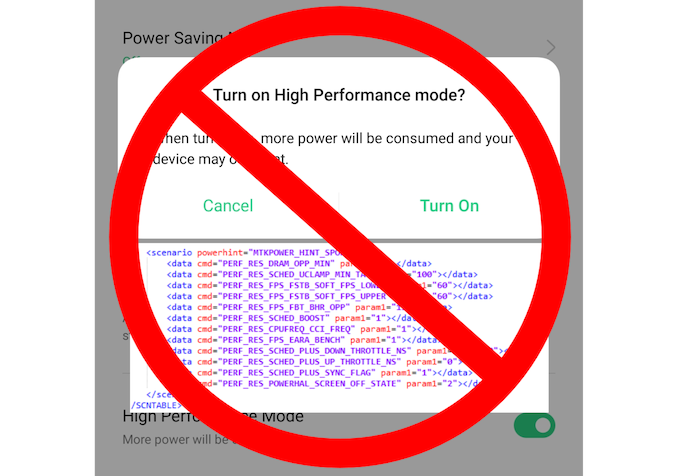
Mobile benchmark cheating has a long story that goes far back for the industry (well – at least in smartphone industry years), and has also been a controversial coverage topic at AnandTech for several years now.
I remember back in 2013 where I had tipped off Brian and Anand about some of the shenanigans Samsung was doing on the GPU of Exynos chipsets on the Galaxy S4, only for the thing to blow up into a wider analysis of the practice amongst many of the mobile vendors back then – with all of them being found guilty. The Samsung case eventually even ended up with a successful $13.4m class-action lawsuit judgment against the company – with yours truly and AnandTech even being cited in the court filing.
The naming and shaming did work over the following years, as vendors quickly abandoned such methods out of fear of media backlash – the negatives far outweighed the positives.
In recent years however we saw a big resurgence of such methods, particularly from Chinese vendors. Most predominantly for our more western audience this happened to Huawei just a couple of generations ago with mechanisms that essentially disabled thermal throttling the of phones – letting more demanding benchmarks essentially have the SoC burn through to the maximum until thermal shutdowns. The naming and shaming here again helped, as the company had transitioned from employing invisible mechanisms to something that was a lot more honest and transparent, and a lot less problematic for follow-up devices.
The problem is, the Chinese vendor market is still huge, and we’re not able to dissect every single device and vendor out there. Cheating in benchmarks here continued to be a very real problem and commonplace practice. Huawei’s rationale back then was that they felt that they needed to do it because others did it as well – and they didn’t want to lose face to the competition in regards to the marketing power of benchmark numbers.
The one big difference here however is that there’s always been somewhat of a firewall in our coverage between what a device vendor did, and what chip vendors enabled them to do, and that’s where we come to MediaTek’s behavior over the last few years. In most past cases we always blamed the device vendors for cheating as it had been their mechanisms and initiative – we hadn’t had evidence of enablement by chipset vendors, at least until now.
Helio P95 outperforming Dimensity 1000L?!
The whole thing got to my attention when I had first received Oppo’s new Reno3 Pro – the European version with MediaTek’s Helio P95 chipset. The phone surprised me quite a bit at first, as in systems benchmarks such as PCMark it was punching quite above its weight and what I had expected out of a Cortex-A75 class SoC. Things got weirder when I received a Chinese Reno3 with the MediaTek Dimensity 1000L – a much more powerful and recent chip, but which for some reason performed worse than its P95 sibling. It’s when you see such odd results that alarm bells go off as there’s something that is quite amiss.
The whole thing ended up as quite the trip down the rabbit hole.
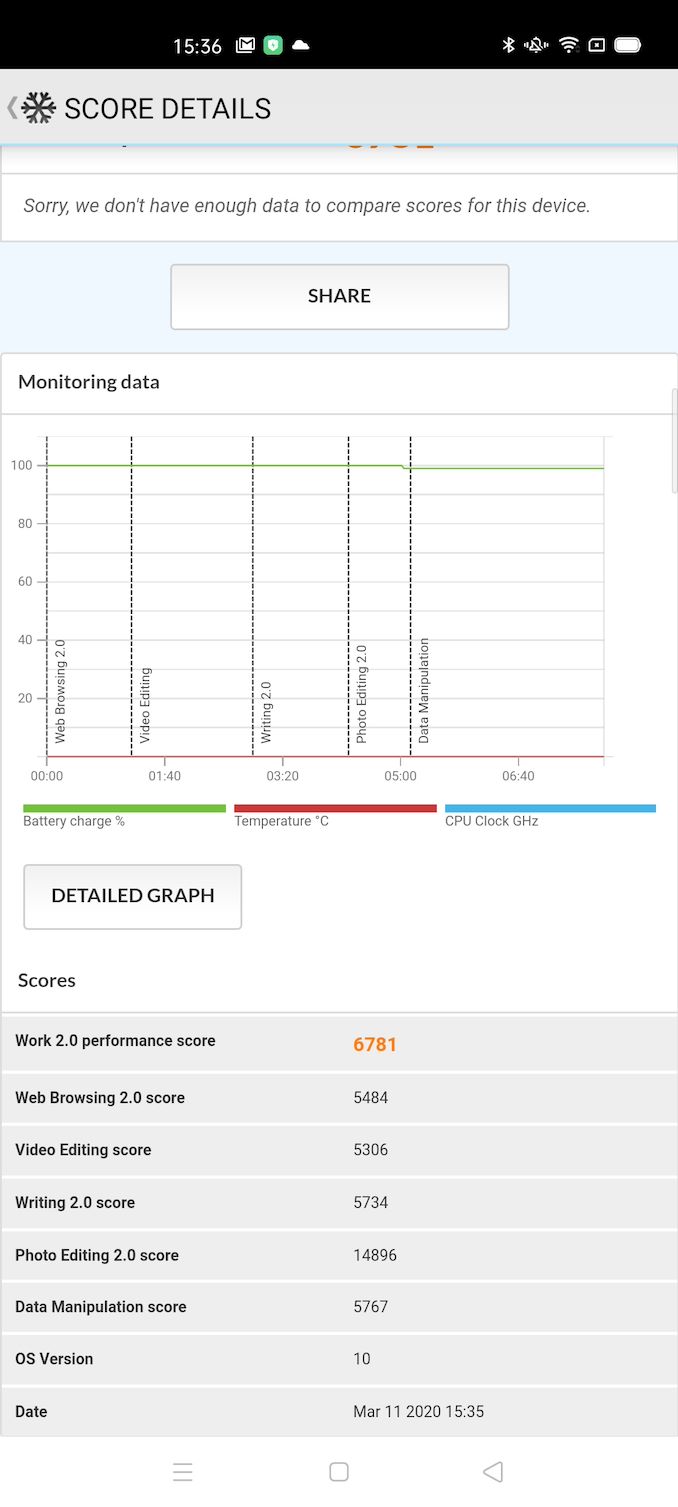
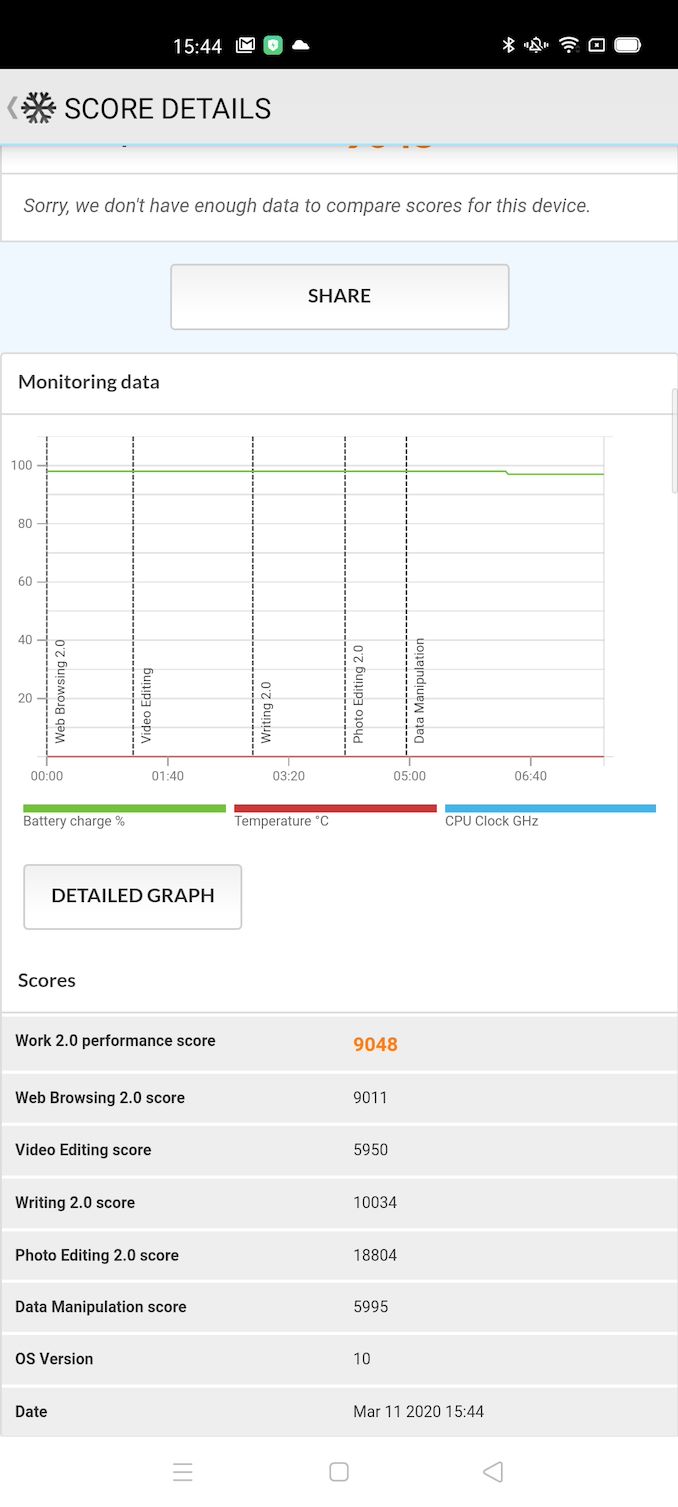
Real Performance vs Cheated Performance
(Oppo Reno3 Pro P95)
Naturally, and unfortunately, my first thought was that there must be some sort of cheating going on. We had reached out to our friends at UL for a anonymised version of PCMark – the teams there in the past had also been a great help in deterring cheating behaviour in the industry. To no major surprise, the two versions of the benchmark did differ in their scores – but I was still aghast at the magnitude of the score delta: a 30% difference in the overall score, with up to a 75% difference in important subtests such as the writing workload.
A bit of background on PCMark and why we use it: it’s not really a benchmark that’s usually being targeted for detection and cheating, because it’s a system benchmark that tries to be representative of real-world workloads and the responsiveness of a device. Whilst the hardware here certainly plays a role here in the benchmark score, it’s mostly affected by software and mechanisms such as DVFS and schedulers. There’s also the fact that it’s a performance and battery benchmark all in one – if you’re cheating in one aspect of the test by increasing performance, you’re just handicapping yourself on the battery test. It's thus unusual for the benchmark to be manipulated as in one sense you're also shooting yourself in the foot at the same time.
I also have a Snapdragon 765G variant of the Reno3 Pro, the Chinese model of the phone (while they share the same name, they’re still quite different devices). If Oppo were to be the cause of this mechanism, surely this device would also detect and cheat in PCMark. But actually that’s not the case: the device seemingly performs in benchmarks just as well as it does in any other app.
Update April 16th: Oppo had reached out to us regarding the whitelist; the company had removed this in the first public OTA of the phone, however the settings persisted in the cache of the device. Resetting the phone to factory defaults on the new firmware removes the detection, and the abnormal benchmark scores.
Digging a bit more for information on the MediaTek versions of the Reno3, the whole cheating mechanism had seemingly been sitting in plain sight to users for several years:

Reno3 Pro - "Sports Mode" Benchmark Whitelist
In the device’s firmware files, there’s a power_whitelist_cfg.xml file, most commonly found in the /vendor/etc folders of the phones. Inspect the file, there we find amongst what seems to be a list of popular applications with various power management tweaks applied to them, with lo and behold, also a list of various benchmarks. We find the APK ID for PCMark, and we see that there’s some power management hints being configured for it, one common one being called a “Sports Mode”.
The benchmark list here isn’t very exhaustive but it does contain the most popular benchmarks in the industry today – GeekBench, AnTuTu and 3DBench, PCMark, and some older ones like Quadrant or popular Chinese benchmark 鲁大师 / Master Lu. There’s also a storage benchmark like AndroBench2 which is a bit odd – more details on that later.
The newest additions here are a slew of AI benchmarks including the Master Lu AIBench and the ZTH AI Benchmark test, both of which we actually actively use here at AnandTech to cover those aspects of SoCs and devices.

Reno3 Pro - Non-public Benchmark Targeting
What actually did shock me though was the inclusion of a corporate version of Kishonti’s GFXBench. It didn’t have the sports mode power hint configured in the listing, but obviously it’s altering the default DVFS, thermal and scheduler settings when the app is being used. This is a huge red flag because at this point, we’re not merely talking about the benchmark list targeting general public benchmarks, but also variants that are actually used by only a small group of people – media publications like ourselves included. This is something to keep in mind for later in the piece.
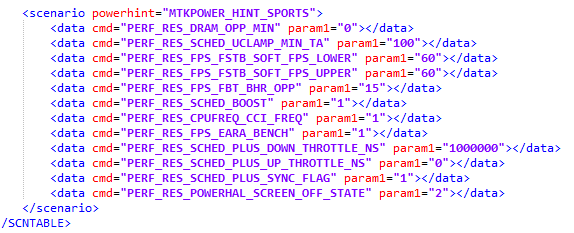
Sports Mode on Reno 3 (Dimensity 1000L)
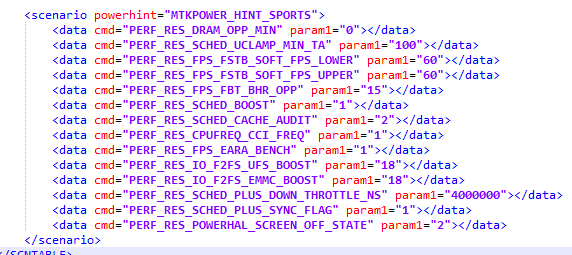
Sports Mode on Reno 3 Pro (P95)
So, what does this “Sports Mode” actually do? For one, it seemingly fixes some DVFS characteristics of the SoC such as running the memory controller at the maximum frequency all the time. The scheduler is also being set up to being a lot more aggressive in its load tracking – meaning it’s easier for workloads to have the CPU cores ramp up in frequency faster and stay there for longer period of time, applying a few familiar boosting mechanisms.
I’m not sure that the _FPS_ entries do, but given their obvious naming they’re altering something to improve benchmark numbers. The oddest thing here are entries that are boosting the filesystem speed on F2FS devices, probably why benchmarks such as AndroBench are also being targeted.
It's (Mostly) All MediaTek Devices
Here’s the real kicker though: those files aren’t just present on OPPO devices, they’re very much present in a whole slew of phones by various vendors across the spectrum. I was able to get my hands on some firmware extracts of various devices out there (I didn’t actually possess every phone here), with each one of them having a similar power_whitelist_cfg.xml present in their vendor partition, with nigh identical entries of the benchmark listings. Here’s a breakdown:
| MediaTek Cheating Devices & Benchmarks | |||||||||
| Vendor | Oppo | Oppo | Oppo | Vivo | Xiaomi | Realme | iVoomi | Sony | |
| Device | Reno Z | F15 | F9 Pro | S1 | Note 8 Pro | C3 | i2 Lite | XA1 | |
| SoC | P95 | P90 | P70 | P60 | P65 | G90 | G70 | A22 | P20 |
| AndroBench2 | ✓ | * | ✓ | ✓ | ✓ | ✓ | ✓ | ✓ | |
| PCMark | ✓ | * | ✓ | ✓ | ✓ | ✓ | ✓ | ✓ | |
| Antutu | ✓ | * | ✓ | ✓ | ✓ | ✓ | ✓ | ✓ | |
| Antutu 3DBench | ✓ | * | ✓ | ✓ | ✓ | ✓ | ✓ | ✓ | |
| GeekBench | ✓ | * | ✓ | ✓ | ✓ | ✓ | ✓ | ✓ | |
| Quadrant | ✓ | * | ✓ | ✓ | ✓ | ✓ | ✓ | ✓ | |
| Quadrant Professional | ✓ | * | ✓ | ✓ | ✓ | ✓ | ✓ | ✓ | |
| 鲁大师 / Master Lu | ✓ | ✓ | ✓ | ✓ | ✓ | ✓ | ✓ | ✗ | |
| 鲁大师 / AIMark | ✓ | ✓ | ✓ | ✓ | ✓ | ✓ | ✗ | ✗ | |
| AI Benchmark (ZTH) | ✓ | ✓ | ✓ | ✓ | ✓ | ✓ | ✗ | ✗ | |
| NeuralScope Benchmark | ✓ | ✓ | ✓ | ✓ | ✓ | ✓ | ✗ | ✗ | |
| GFXBench 4 Corporate | ✓ | ✗ | ✗ | ✓ | ✓ | ✓ | ✗ | ✗ | |
* Present but commented out
What’s shocking here is just the wide variety of devices that this is present on. The oldest device here being a Sony XA1 with a P20 from 2016, pointing out that this possibly has been around for some time. That device also had seemingly the least “complete” list of benchmarks, notably lacking the newer AI tests.
The fact that the Sony had this in the files is most concerning as it should be a vendor that’s “clean” and avoiding such practices. What clear here is that this mechanism isn’t stemming from the individual vendors, but originates from MediaTek and is integrated into the SoC’s BSP (Board Support Package).
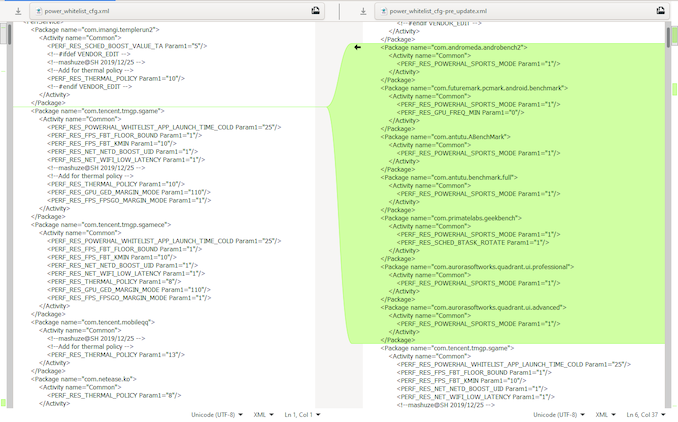
Oppo Reno3 Pro (P95) - New Firmware vs Initial Firmware (Listings gone)
What’s actually even more suspicious and we’re very lucky here in terms of catching this, is that these listings are seemingly in the process of being hidden. I had extracted the files out of my Reno3 Pro on its initial out-of-the-box firmware. Over the last few weeks OPPO had pushed a firmware update to the phone – and when at some point when I had checked something again in the file, I was surprised to see the benchmark entries disappear.
Did the mechanism get disabled? Did they stop cheating? Unfortunately, no. I don’t know where the entries have been moved to now, but the phone still very much still triggered its Sports Mode in the benchmarks with the same large performance boost. The entries weren’t merely removed, they were just hidden away somewhere else.
Update April 16th: Oppo had reached out to us regarding the whitelist; the company had removed this in the first public OTA of the phone, however the settings persisted in the cache of the device. Resetting the phone to factory defaults on the new firmware removes the detection, and the abnormal benchmark scores are gone.
It's to be noted that seemingly Oppo wasn't fully aware of the mechanism - and there was confusion as to how properly disable it. It points out that MediaTek has this mechanism enabled by default in their BSP.
Reaching Out To MediaTek & Their Response
We were extremely concerned about all these findings, and we reached out to MediaTek several weeks ago. We explained our findings, and the concerns we had of a SoC vendors actually providing such a mechanism. We recently finally got an official response from them, quoted as follows:
MediaTek Statement for AnandTech
MediaTek follows accepted industry standards and is confident that benchmarking tests accurately represent the capabilities of our chipsets. We work closely with global device makers when it comes to testing and benchmarking devices powered by our chipsets, but ultimately brands have the flexibility to configure their own devices as they see fit. Many companies design devices to run on the highest possible performance levels when benchmarking tests are running in order to show the full capabilities of the chipset. This reveals what the upper end of performance capabilities are on any given chipset.
Of course, in real world scenarios there are a multitude of factors that will determine how chipsets perform. MediaTek’s chipsets are designed to optimize power and performance to provide the best user experience possible while maximizing battery life. If someone is running a compute-intensive program like a demanding game, the chipset will intelligently adapt to computing patterns to deliver sustained performance. This means that a user will see different levels of performance from different apps as the chipset dynamically manages the CPU, GPU and memory resources according to the power and performance that is required for a great user experience. Additionally, some brands have different types of modes turned on in different regions so device performance can vary based on regional market requirements.
We believe that showcasing the full capabilities of a chipset in benchmarking tests is in line with the practices of other companies and gives consumers an accurate picture of device performance.
The statement is generally disappointing, but let’s go over a few key points that the company is trying to make.
The statement tries to say that by forcing the various configurable knobs, the benchmark figures will better represent the hardware capabilities of the SoC. In a sense, this is actually true and it’s been a contentious talking point regarding the whole benchmark cheating debacle over the years with various vendors. It’s only when a benchmark vendor suddenly opens up otherwise unattainable performance states in these benchmarks where the argument isn't valid anymore. At least at first glance, it doesn’t appear to be the case for MediaTek – although I don’t have more detailed technical information as to what some of the "Sports Mode" configuration options do.
The problem with that argument though, is that it falls apart in the face of cheating benchmarks that not only target the actual hardware components of a SoC – like how GeekBench is testing the CPU speeds or how GFXBench checks out the how fast a GPU can be, but also benchmarks which actively try to be user experience benchmarks, such as PCMark. This is a real-world mimicking workload that tries to convey the responsiveness of a phone as a whole, not just the chipset.
The fact that MediaTek cheats such a test goes directly against their second paragraph notion of the chipsets offering optimized performance in the real-world. If that were the case, then wouldn’t it be better to actually let the chipset and software honestly demonstrate this? What does cheating storage benchmarks and filesystems have anything to do with the chipset’s capabilities?
MediaTek’s claim of vendors offering dedicated performance modes is correct. Most notably this had been introduced, at least for vendors such as Huawei – as a direct result of us calling them out on the default opaque cheating behavior of their devices.
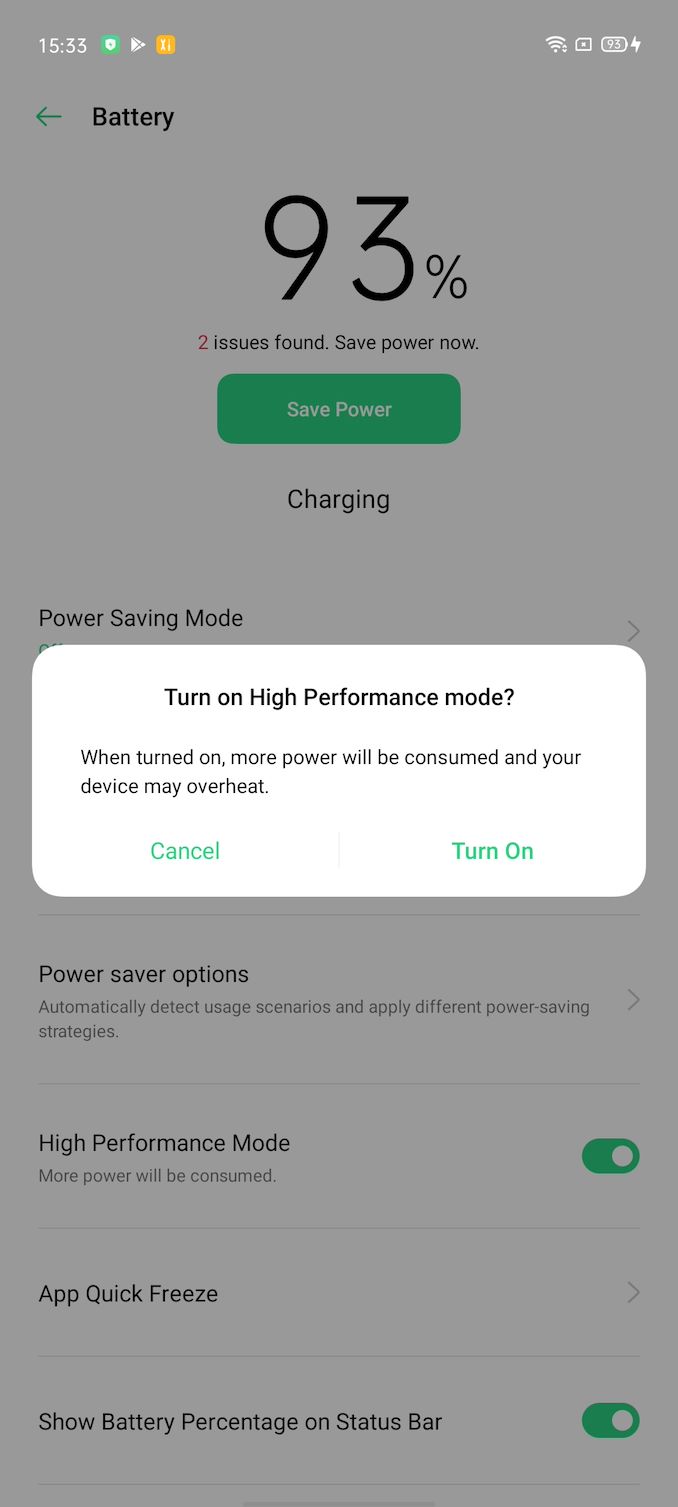
High Performance Mode Prompt on OPPO devices.
On the Oppo devices, and many other Chinese vendor devices, they put on a “High Performance Mode” option in the settings. This actually differs quite a bit from the usual “High Performance” modes we’re used from vendors such as Samsung or more lately Huawei, in that this is essentially just a switch to have the DVFS and performance tuneable go bonkers. It’s present also in Snapdragon phones, and we had talked about it in our review of the Reno 10x last year. The phone essentially goes into a high-power mode throwing away any attempt to be efficient; it’s a nonsensical mode that is unusable in every-day use-cases beyond getting high benchmark scores.
The thing is – we as hopefully educated users, and MediaTek as a SoC vendor – should not care about these operating modes.
I still view it as a good compromise between delivering the phones in an honest “default” state, and still giving the option for people (and reviewers) out there to achieve unrestricted, super high benchmark figures if they so desire. The difference here it’s the transparency of the mechanism – Oppo for example outright tells you your device will overheat. MediaTek’s benchmark detection on the other hand is hidden.
MediaTek also refers to “market requirements” making them do this and it being an “industry standard”, and unfortunately that’s again true and addresses the core of the issue.
These mechanisms wouldn’t exist if there weren’t a demand by vendors for MediaTek to provide such solutions. From MTK’s perspective, they’re just trying to satisfy a customer’s needs and make them happy. There’s the question of whom actually came first – was it MTK developing the detection on their own, or was it some customer that demanded it from them at some point in the past?
Lacking evidence of other SoC vendors out there enabling similar mechanisms for the device vendors, what’s clear is that MediaTek should just have stayed out of the mess, as they have more to lose than there is to gain.
All that’s been achieved now is the impression that the company’s chipset software isn’t optimized enough to be able to deliver consistent performance and efficiency by default, with it instead needing a manual push to be able to properly match their benchmark expectations of the chipsets.
I’ve certainly lost a lot of confidence in the figures and in general just being more skeptical of the benchmark figures I’m running – particularly at a time where I was excited to see MediaTek come back to the high end with the Dimensity 1000 (which is seemingly a very good chipset – review to follow up in the future).
With the cat out of the bag and with the evidence out there, I’m sure other media with access to more MediaTek devices will be able to check whether they’re cheating or not. Pointing and shaming has worked in the past for Samsung and other vendors, and it worked for Huawei’s misjudgments a few years back – both being on a more correct path now. I just hope MediaTek is able to also correct their trajectory here, take the high road, remove the mechanisms – and say "no" to their customers when they request such a feature again.










111 Comments
View All Comments
iphonebestgamephone - Friday, April 10, 2020 - link
" SD660 and Helio P60 have very close scores...And have very close behavior..." - well thats certainly not the case with p95 and something like sd855. P95 cheated score gives pcmark 2.0 score of 9048, and oneplus 7 pro gives 9892, around 9% difference. Is there really that much difference in real life usage? Its a 2.2 ghz a75 vs 2.8/2.4ghz a76. I dont think so.
Plumplum - Friday, April 10, 2020 - link
Yes, you're probably right...Even if P95 bas very good triple ISP and IA that can help in tests like photo editing, difference should be higher! I'm agree.
And 7000pts on SD710 when D1000L's score is 6800?
Wake up!
2 Cortex A75 vs 4 A77
Adreno 616 vs Mali G77mp9 at least twice more powerfull
2 ISP vs 5
DSP+GPU vs 6 cores APU for IA
Better video support!
If SD710 marks 7000, D1000L should mark 14000!!!
As I said with my exemple about X20 and Rk3288, you can't trust in PCMark!
But all the Media spit on Mediatek!
They'd better think a little, see task scheduling can't lead to 75% differences (totally absurd!!!), makes some other tests and see if the problem isn't...PCMark!
iphonebestgamephone - Friday, April 10, 2020 - link
I dont know if the device you mentioned with sd710 cheats or not, dont care.So the p95 has a better isp than 855 and that helps in photo editing scores on pcmark? About trusting pcmark or not, isnt it clear that p95 is cheating here? The non cheat score gives 30% difference compared to sd855 - this makes sense given the better cpu/gpu. I would like to see what score a cheated sd855 gives. If you want to talk about other devices redmi note 8 pro gives 10k score lol.
Plumplum - Friday, April 10, 2020 - link
You can't get 30% extras with task scheduler modification, it's absurd!Any developer should ask himself some questions when seeing that kind of behavior.
Try to Root a device and change governor to "performance" (in this mode, device is always at max frequency), usually you will get maybe 5% extra score on modern devices.
All you win is few milliseconds of full speed frequency.
The question is : does PCMark use properly P95 unless the Rom force it?
What is absolutely certain is that Dimensity 1000L is badly used.
PCMark's code isn't optimised on some soc...that's a fact!
I know for Redmi Note 8 Pro, I'm writing on it...
There's some funny thing with an other part of PCMark...Computer Vision Test (AI) is only 10% better than Helio P60's, I'm nearly certain some part of AI hardware is unused.
iphonebestgamephone - Saturday, April 11, 2020 - link
"You can't get 30% extras with task scheduler modification, it's absurd" - it is possible if you increase thermal throttling value. Also pcmark doesnt usually use all cores at max clock for its tasks. This sports mode keeps max clocks and increases throttling values, so it does seem possible. If the throttling value is higher it can keep it up for the entire test, which is like 5 minutes i think. Isnt it really the rom forcing it? What else is that code for? And it is provided by mediatek to oppo and xiaomi.Where can i see the dimensity 1000L scores? Its not mentioned in this article, unless i missed it somehow. Its not on the ulbenchmark site either. A sd855+ rog 2 gives 14k, another result of some sort of game mode i think, its also somewhatof a cheat.
Plumplum - Saturday, April 11, 2020 - link
Thermal throttling won't exist on a 5 minutes test like PCMark (not on any Mediatek's at all, even with it's ten cores ontinuiously at max frequencies, X20 start throttling a little around ten minutes...maybe on SD810 on this one problems can start around 2 minutes)Modify thermal throlling can change something on longer tests (some gfxbench long term performances for exemple) But not on this one.
Temperatures will be around 35 maybe up to 37 at maximum...
So it's not Thermal throttling.
The only way is to boost frequencies.
And this is something visible because PCMark have monitoring data
Or should be visible...one more think that doesn't work properly on P95 (there are many that don't work on PCMark!!!)
You can launch the test on Redmi Note 8 Pro (I do, it's on the list), score is around 9800...CPU never goes over the nominal 2.05ghz, CPU is even not at full frequency all the time, sometime it's under 0.6ghz...max temperature is 36°
I try on Amlogic S912, test fail and can't display results...one more
So it's not overclocking.
Yes you're right, application doesn't use all cores at max clock
Root a device, tweak governor to performance mode (max frequency all the time), you will get 5% extra score on most the tests you will run.
I would like to see real investigations with Antutu "cheated/not cheated", geekbench "cheated/not cheated"...
I doubt differences goes over 5%
If problem is only on PCMark, then it's the faulty part...the app doesn't work properly the hardware untill the system force it to do.
See on detailed score. The parts mostly impacted by "cheated" mode are CPU oriented...web browsing, data manipulation, writing...my hypothesis is PCMark forget to use Cortex A75 and use A55 instead...this kind of thing can lead to 70% differences!
And this kind of thing already happen for exemple on Vernee Apollo's Helio X20.
In your opinion, is it normal that a benchmark, made to test capabilities of a device runs on economic cores?
On one point, You're right, my bad...confusion between so called "non cheated" score on P95 and D1000L's...
Lower than P95, that mean less than 9000...impossible that PC Mark work properly in this case.
14k on SD855+ aren't strange in my opinion. Based on specifications, I expect D1000L around 12k and D1000 around 15k.
iphonebestgamephone - Saturday, April 11, 2020 - link
Yeah maybe it doesnt throttle much in 5 minutes, i do see the word 'throttle' in that sports mode code though, and values are different from d1000l. If all cores are at max clock, the performance does decrease a bit even in 5 minutes, atleast on my 7pro sd855 it lost 6% with the cpu throttling app under 5 minutes. Is the p95 so much better that it wont lose even 1% under same conditions? Dont think so. Thats where the low throttling of sports mode helps, if it does indeed modify throttling.What are you talking about 37 maximum? Surely its not cpu temps right? Because those are a lot higher under max clock. Or is the p95 so great that it runs at 37 under full load?
It is indeed surprising that note 8 pro doesnt use max clock but still manages a score that matches sd855. wonder what the sport mode on it even does. When i tested on sd855, the prime core is at the lowest clock of 800mhz. Other cores werent at fullspeed either. I think the high score on rog 2 is because it forces max clocks. Its even higher than some sd865 devices.
The reason i think they dont force max clocks is because pcmark tries to find a balance between performance and battery life since its supposedly doing daily use tasks as a benchmark. They should do the non cheat version pcmark for all phones
SolarBear28 - Friday, April 10, 2020 - link
Certainly Qualcomm has done very many shady things and has abused it's monopoly position with modem tech. I'm not defending them in any way. And I'm not suggesting that Mediatek make poor chips. I'm only calling them out for defending obvious attempts to create misleading benchmark scores.I can't speak to other media outlets, but I believe Anandtech is one of the most objective. They have never hesitated to call out anyone in the past. Others may have, or are currently, getting away with cheating, but we should always continue to call it out at every opportunity.
Plumplum - Friday, April 10, 2020 - link
Attempt is obvious...I'm against this kind of behavior too.
but extrascore should be around 5% and totally invisible in real life for users
For exemple, P95 is technically very close to SD710...Antutu v8's score are very close too...220.000 and 214.000. That's the kind of difference you can see. Is it important? I don't think so...people won't care.
Problem is Anandtech start talking about 75%
That's important. And in my opinion this isn't the result of cheating. That's not serious to believe it!
Anandtech analysis isn't complete.
1) on applications that work properly, it's impossible to get 30 or 75% extra performances with what Mediatek does. (We're talking about winning a few milliseconds of CPU max frequency on a ten minutes long test!)
2) see if extrascore on other benchmarks is as huge to confirm 1)
3) some investigation on other soc should be done...for exemple why SD710's score is 7000pts when twice more powerfull D1000L's is only 6800pts.
According to these points, is it reasonnable to trust in PCMark like Anandtech does?
Does Mediatek cheats to prevent badly coded benchmarks?
Why PCMark's developers don't verify their code when they see D1000L's score that doesn't fit to its technical specifications?
In playstore, I wrote to PCMark years ago about some problem on Helio X20 (unused cortex A72), answer was ridiculous. It really seems that they forget to test their work on soc from Mediatek or Rockchip...and even refuse to verify when people report problems.
Just test on Realtek RTD1195, it's even worst : app crashed after video editing test...
Tommorow I will try on Amlogic S912.
I like very much what is tested in PCMark Work 2.0, I think it's clever...but fiability isn't there for many soc. There are many exemple.
Used to trust in Anandtech too...but not in this case.
They can't be perfect all the Time.
SolarBear28 - Friday, April 10, 2020 - link
You seem very quick to jump to conclusions. I am not an expert. But with some quick googling I can see the 75% difference (in Writing 2.0) is for a specific workload that measures the time to open, edit and save text and pdf documents. Changing how quickly the memory and CPU get to maximum frequency could make a 75% difference in this type of task. That test could also be influenced by numerous other things such as the type of internal storage and how the SOC is configured to access internal storage. The phone with the most powerful CPU cores doesn't always win every real world benchmark.